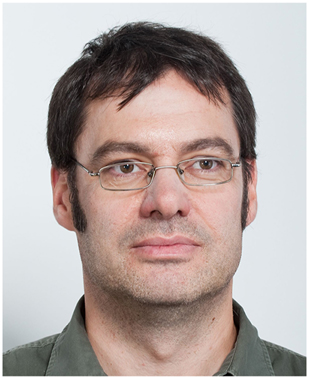Active deep learning for segmentation of industrial CT data
-
Markus Michen
Abstract
This contribution proposes an approach and the respective tool that uses Active Deep Learning (ADL) to segment industrial three-dimensional computed tomography (3D CT) data. The general approach is application-independent and includes an iterative human-in-the-loop Active Learning (AL) process that produces labeled training data and a trained Deep Learning (DL) model for semantic segmentation. The model is continuously improved during iterations such that manual labeling effort is reduced. In addition, the user can minimize user interaction with the aid of a random forest-based classifier and focus on unclear or invalid segmentation results. The complete workflow is implemented within one single Python tool. The approach is demonstrated in detail for two industrial use cases: Single fiber analysis and plant segmentation. For plant segmentation, the method is compared to a baseline and a classic image processing algorithm.
Zusammenfassung
In diesem Beitrag werden ein Ansatz und ein entsprechendes Tool vorgestellt, das Active Deep Learning (ADL) für die Segmentierung industrieller dreidimensionaler Computertomographiedaten (3D CT) verwendet. Der allgemeine Ansatz ist anwendungsunabhängig und beinhaltet einen iterativen Active Learning (AL)-Prozess, der gelabelte Trainingsdaten und ein trainiertes Deep Learning (DL)-Modell für die semantische Segmentierung erzeugt. Das Modell wird in Iterationen kontinuierlich verbessert, wodurch der manuelle Labeling-Aufwand reduziert wird. Darüber hinaus ermöglicht ein Random-Forest-basierter Klassifikator dem Benutzer, die Benutzerinteraktion zu minimieren und sich auf unklare oder ungültige Segmentierungsergebnisse zu konzentrieren. Der gesamte Arbeitsablauf ist in einem einzigen Python-Tool implementiert. Der Ansatz wird im Detail für zwei industrielle Anwendungsfälle demonstriert: Einzelfaseranalyse und Pflanzensegmentierung. Für die Pflanzensegmentierung werden die Ergebnisse mit und ohne Active Learning einem klassischen Bildverarbeitungsalgorithmus gegenübergestellt.
About the authors

Wissenschaftlicher Mitarbeiter in der Gruppe Bildverarbeitung, Markus Michen ist Wissenschaftlicher Mitarbeiter in der Forschungsgruppe Bildverarbeitung am Entwicklungszentrum Röntgentechnik. Er entwickelt Algorithmen für die deep learning basierte Auswertung und Segmentierung von industriellen CT Daten. Weitere Forschungsinteressen sind DL basierte CT sowie Objektdetektion und Klassifikation mittels CNNs.

Senior Engineer in der Gruppe Bildverarbeitung, Markus Rehak ist Senior Engineer in der Forschungsgruppe Bildverarbeitung am, Entwicklungszentrum Röntgentechnik. Er entwickelt Algorithmen für die, Auswertung dreidimensionaler Röntgendatensätze. Weitere Forschungsinteressen, sind das High-Performance-Computing mit Hilfe der Vektoreinheiten moderner CPUs, sowie die Programmierung von Grafikkarten.

Leiter der Forschungsgruppe Bildverarbeitung, Ulf Haßler ist Leiter der Forschungsgruppe Bildverarbeitung am, Entwicklungszentrum für Röntgentechnik. Seine Forschungsinteressen liegen in, der Entwicklung von Algorithmen und Tools zur automatisierten Erfassung und Visualiserung, relevanter Strukturinformationen aus dem Bereich der zerstörungsfreien Prüfverfahren, hauptsächlich Computertomographie.
-
Author contributions: All the authors have accepted responsibility for the entire content of this submitted manuscript and approved submission.
-
Research funding: This work was partly supported by the Bavarian Ministry for Economic Affairs, Infra-structure, Transport and Technology through the Center for Analytics Data Applications (ADA-Center) within the framework of “BAYERN DIGITAL II”.
-
Conflict of interest statement: The authors declare no conflicts of interest regarding this article.
References
[1] O. Ronneberger, P. Fischer, and T. Brox, “U-Net: convolutional networks for biomedical image segmentation,” in International Conference on Medical Image Computing and Computer-Assisted Intervention, Springer, 2015, pp. 234–241.10.1007/978-3-319-24574-4_28Search in Google Scholar
[2] Ö. Çiçek, A. Abdulkadir, S. L. Ahmed, et al.., “3D U-Net: learning dense volumetric segmentation from sparse annotation,” in International Conference on Medical Image Computing and Computer-Assisted Intervention, Springer, 2016, pp. 424–432.10.1007/978-3-319-46723-8_49Search in Google Scholar
[3] M. J. Cardoso, W. Li, R. Brown, et al.., “MONAI: an open-source framework for deep learning in healthcare,” 2022. https://arxiv.org/abs/2211.02701.Search in Google Scholar
[4] J. Deng, W. Dong, R. Socher, et al.., “Imagenet: a large-scale hierarchical image database,” in 2009 IEEE Conference on Computer Vision and Pattern Recognition, IEEE, 2009, pp. 248–255.10.1109/CVPR.2009.5206848Search in Google Scholar
[5] B. Settles, Active Learning Literature Survey, Madison, University of Wisconsin-Madison Department of Computer Sciences, 2009.Search in Google Scholar
[6] V. Nath, D. Yang, B. A. Landman, D. Xu, and H. R. Roth, “Diminishing uncertainty within the training pool: active learning for medical image segmentation,” IEEE Trans. Med. Imag., vol. 40, pp. 2534–2547, 2021. https://doi.org/10.1109%2Ftmi.2020.3048055.10.1109/TMI.2020.3048055Search in Google Scholar PubMed
[7] J. Seok-Ki, L. Ho-Kyung, L. Seungjun, Y. Cho, and I. S. Song, “Deep active learning for automatic segmentation of maxillary Sinus lesions using a convolutional neural network,” MDPI Diagnostics, vol. 11, no. 4, p. 688, 2021. https://doi.org/10.3390/diagnostics11040688.Search in Google Scholar PubMed PubMed Central
[8] M. Teßmann, S. Mohr, U. Haßler, et al.., “Automatic determination of fiber-length distribution in composite material using 3D CT data,” EURASIP J. Adv. Signal. Process., vol. 2010, pp. 1–9, 2010.10.1155/2010/545030Search in Google Scholar
[9] M. Yosifov, P. Weinberger, B. Fröhler, et al.., “The long journey to the training of a deep neural network for segmenting pores and fibers,” in Proceedings of the Industrial Computed Tomography Conference (iCT) 2022, 2022.10.58286/26610Search in Google Scholar
[10] P. Weinberger, J. Maurer, B. Fröhler, et al.., “Faster training of deep convolutional neural networks for material science through transfer learning,” Idea, vol. 4, p. 5, 2020.Search in Google Scholar
[11] M. Rehak, U. Haßler, T. Grulich, et al.., “Der phenoTest–Ein automatisiertes CT-System zur Phänotypisierung von Zuckerrübenkeimlingen,” in Der phenoTest–Ein automatisiertes CT-System zur Phänotypisierung von Zuckerrübenkeimlingen, Karlsruhe, KIT Scientific Publishing, 2018, pp. 217–228.Search in Google Scholar
[12] F. Pedregosa, G. Varoquaux, A. Gramfort, et al.., “Scikit-learn: machine learning in Python,” J. Mach. Learn. Res., vol. 12, pp. 2825–2830, 2011.Search in Google Scholar
[13] S. Ioffe and C. Szegedy, “Batch normalization: accelerating deep network training by reducing internal covariate shift,” in International Conference on Machine Learning, PMLR, 2015, pp. 448–456.Search in Google Scholar
[14] S. Elfwing, E. Uchibei, and K. Doya, “Sigmoid-weighted linear units for neural network function approximation in reinforcement learning,” Neural Networks, vol. 107, pp. 3–11, 2018.10.1016/j.neunet.2017.12.012Search in Google Scholar PubMed
[15] F. Isensee, J. Petersen, A. Klein, et al.., “nnu-net: self-adapting framework for U-Net-based medical image segmentation,” 2018, arXiv preprint arXiv:1809.10486.10.1007/978-3-658-25326-4_7Search in Google Scholar
[16] D. Kingma and J. Ba, “Adam: a method for stochastic optimization,” 2014, ArXiv Preprint ArXiv:1412.6980.Search in Google Scholar
[17] I. Loshchilov and F. Hutter, “Decoupled weight decay regularization,” 2017, arXiv preprint arXiv:1711.05101.Search in Google Scholar
[18] A. Martín, A. Ashish, B. Paul, et al.., TensorFlow: Large-Scale Machine Learning on Heterogeneous Systems, 2015. Available at: https://www.tensorflow.org/,Softwareavailablefromtensorflow.org%20Software%20available%20from%20tensorflow.org.Search in Google Scholar
[19] F. Pérez-García, R. Sparks, and S. Ourselin, “TorchIO: a Python library for efficient loading, preprocessing, augmentation and patch-based sampling of medical images in deep learning,” Comput. Methods Progr. Biomed., vol. 208, 2021, Art no. 106236. https://doi.org/10.1016/j.cmpb.2021.106236.Search in Google Scholar PubMed PubMed Central
[20] A. Frangi, W. Niessen, K. Vincken, et al.., “Multiscale vessel enhancement filtering,” in International Conference on Medical Image Computing and Computer-Assisted Intervention, Springer, 1998, pp. 130–137.10.1007/BFb0056195Search in Google Scholar
© 2023 Walter de Gruyter GmbH, Berlin/Boston
Articles in the same Issue
- Frontmatter
- Editorial
- Image Processing Forum – Forum Bildverarbeitung 2022
- Research Articles
- Image quality improvement through turbid media by using graphene nanoplates
- Diffraction-based dual path multispectral imaging
- Bildbasierte Bestimmung der räumlichen und zeitlichen Verteilung des Brechungsindex während der Aushärtung von Polymeren in der additiven Fertigung von Optiken
- Real-time vignetting compensation and exposure correction for panoramic images by optimizing irradiance consistency
- Quantum image processing on real superconducting and trapped-ion based quantum computers
- Almost lossless compression of noisy images
- Local performance evaluation of AI-algorithms with the generalized spatial recall index
- Finding optimal decision boundaries for human intervention in one-class machine-learning models for industrial inspection
- Simulation study and experimental validation of a neural network-based predictive tracking system for sensor-based sorting
- Active deep learning for segmentation of industrial CT data
- Machine learning based geometry reconstruction for quality control of laser welding processes
- A comparison of learning-based approaches for the corrosion detection on barrels in industrial applications
Articles in the same Issue
- Frontmatter
- Editorial
- Image Processing Forum – Forum Bildverarbeitung 2022
- Research Articles
- Image quality improvement through turbid media by using graphene nanoplates
- Diffraction-based dual path multispectral imaging
- Bildbasierte Bestimmung der räumlichen und zeitlichen Verteilung des Brechungsindex während der Aushärtung von Polymeren in der additiven Fertigung von Optiken
- Real-time vignetting compensation and exposure correction for panoramic images by optimizing irradiance consistency
- Quantum image processing on real superconducting and trapped-ion based quantum computers
- Almost lossless compression of noisy images
- Local performance evaluation of AI-algorithms with the generalized spatial recall index
- Finding optimal decision boundaries for human intervention in one-class machine-learning models for industrial inspection
- Simulation study and experimental validation of a neural network-based predictive tracking system for sensor-based sorting
- Active deep learning for segmentation of industrial CT data
- Machine learning based geometry reconstruction for quality control of laser welding processes
- A comparison of learning-based approaches for the corrosion detection on barrels in industrial applications

